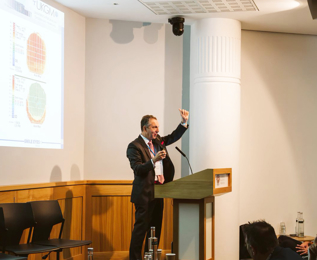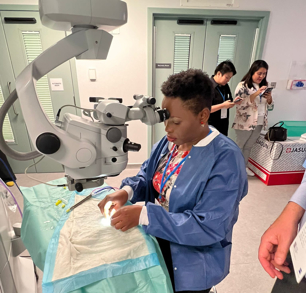
The fourth annual Symposium Contemporary Solutions for Cataract & Refractive Surgery took place recently at the Royal Society of Medicine and Optegra’s flagship hospital in Queen Anne Street, Central London.
The blistering hot weather did not deter around 100 attendees travelling from Germany, Poland and around the UK. The multidisciplinary CPD accredited event was targeted at eye health care professionals and included health care technicians, ophthalmic nurses, optometrists and surgeons.
The event, organised by Optegra Eye Sciences and Zeiss Academy, provided attendees with updates on the latest technology in cataract and refractive surgery, including techniques and trends for laser vision correction and advanced technology implants.
The symposium offered clinical and research lecture content, hands-on wet labs, a range of workshops, peer discussion and interactive case discussion sessions. Attendees, from both hospital and community settings, had ample opportunity to network and also discuss online visual recognition interactive quizzes accessible from their mobile phones.
From rabbits to hyperopia 
Keynote speaker Professor Walter Sekundo shared his experience of the journey and key milestones leading to the successful development of launch of small incision lenticule extraction (SMILE) eye surgery as we know it today.
Professor Sekundo enthralled and captivated the audience with his engaging talk, including anecdotes of his very early research days ‘chasing rats around the laboratory’, to the challenges faced from opponents and naysayers in the early development stages of SMILE surgery technology.
Importantly, Professor Sekundo was keen to relay to the audience SMILE is no longer a ‘new’ surgical procedure with over 7,000,000 eyes treated successfully worldwide.
He highlighted how international research and collaboration have allowed further innovation to the lenticule extraction technology, including SMILE combined with accelerated cross-linking (SMILE Extra),1 the use of toric lenticule implantation with the triple marking method to correct hyperopia and hyperopic astigmatism following small incision lenticule intrastromal keratoplasty (SMI-LIKE).2
To conclude his talk, Professor Sekundo shared his ‘decision tree’ of the perfect candidate for SMILE, including those with complex myopia, thin corneas, dry eyes and professions where the creation of a flap may be a contraindication to treatment, eg professional boxers.
Market trends over time
Charlie Reed (Zeiss) gave an overview of the current market trends for the provision of cataract and refractive surgery treatment. Some 28.2 million cataract procedures done in 2022 and this was expected to grow to 38.3 million in 2027.
Strikingly, it was reported that Covid-19 created a global cataract surgery backlog of over 10 million cataract eyes during 2020 and 2021.3
It was also highlighted how the number of ophthalmologists being trained within the private sector was increasing and how essential training provision is so that we can future-proof the delivery of much needed eye care in hospitals for patients.
Dr Clare O’Donnell, Charlie Reed, Claire Martin (Zeiss), Dr Nabila Jones and Haley Coates (Zeiss)

Advancements in IOL surgery
This dual lecture was delivered by Amir Hamid, Optegra’s medical director, and Shafiq Rehman, consultant ophthalmologist.
Hamid provided a thorough overview of intraocular lenses and how they are differentiated by properties, materials and optical lens design, and the impact of the material properties such as IOL refractive index, hydrophobicity and hygroscopy were detailed.
Hamid provided a functional overview of intraocular lens types; including those that provide a full range of focus (multifocal), extended range of focus, enhanced monofocal and monofocal lenses as well as intraocular lens types currently being researched and refined (light adapting and the latest in accommodating lenses).
A focus on patient counselling for neuroadaptation with a multifocal intraocular lens was emphasised.
Rehman discussed immediate sequential same day bilateral cataract surgery (SSDBCS). He advised the advancement and practice of refractive and cataract surgery has been growing at pace since the Covid-19 pandemic.
Advantages of SSDBCS including avoidance of anisometropia, reduced clinical visits, theatre real state efficiency, and disadvantages including the risk of serious bilateral complications (cystoid macular oedema, toxic anterior segment syndrome (TASS) and endophthalmitis), increased surgery time and IOL power prediction surprises were discussed.
Rehman shared his personal experiences of SSDBCS including emerging audit data. He highlighted a need for further research in this area of practice. The literature on SSDBCS for refractive lens exchange and implantable contact lenses4-7 was reviewed and discourse on when not to recommend SSDCBCS was also included.
Contraindications to SSDCBCS highlighted included carer status (lives alone), uncertain post-surgery compliance, severe diabetic eye disease, immunocompromised patients, severe blepharitis and recurrent uveitis.
Hands-on interactivity 
After lunch, delegates took a short stroll to the Optegra London Eye Hospital where they were given the opportunity to try their hand at surgery in wet labs for cataract surgery and laser vision correction.
Delegates practised loading intraocular lenses into injectors and carrying out phacoemulsification on model eyes. For the laser wet lab sessions, delegates were given the opportunity to perform SMILE surgery on porcine eyes; with varying degrees of success.
Discussion workshops covered a range of topics, including complex biometry (as in post-laser vision correction and irregular cornea cases), widefield optical coherence tomography and peer review sessions on patient selection and the management of post-operative complications and best interests and consent were delivered.
Innovations
Hamid provided an overview of innovations of diagnostic techniques including corneal tomography, topography, ocular biometry, OCT and ultra-widefield imaging. Advantages and personal experiences of the latest systems to manage and streamline surgical planning were outlined.
Three key points highlighted about such systems include the time saving, safety aspects (helping to protect against ‘never events’), and access to pertinent data from almost anywhere.
Innovative vision correction treatments covered included Presbyond laser vision correction for presbyopes and phakic IOLs including, implantable collamer lenses (ICLs).
Emerging presbyopia solutions discussed included a new extended range of focus ICL for presbyopes, crystalline lens softeners (1.5% lipoic acid choline ester ophthalmic solution) and pharma (miotic) solutions for presbyopia (such as pilocarpine 1.25 %, now FDA approved).8
Pharma solutions off a non-invasive reversible solution with no downtime required. However, reported side effects include headaches in up to 15% of patients, red eyes pain and blurred vision and to reduce adverse effects combination formulations that include anti-inflammatories are available.
Reporting Clinical Outcomes
Dr Clare O’Donnell, head of Eye Sciences, and Dr Nabila Jones, Eye Sciences associate, covered clinical outcome reporting and the need for a standardisation of approach. They outlined how clinical audit is an integral part of quality assurance and that claims of excellence must be evidenced.
How and why clinical outcomes data are collated and the importance of dissemination of this data to key stakeholders. The benefits of contributing to national and international audits, such the National Ophthalmology Database audits for cataract and AMD, were discussed.
A key message was that robust processes for collecting and managing clinical outcomes data ultimately leads to improvements in patient care.
Dr O’Donnell also highlighted the importance of collaborative research for the benefit and improvement of patient care and shared data longer term patient reported outcomes following refractive lens exchange and the reduced impact of SMILE versus LASIK on corneal innervation and dry eye signs and symptoms.9
Interactive case discussions
To round off the day, an interactive case review session provided another opportunity for discussion and collaboration between peers and an expert panel, and facilitated sharing ideas for clinical problem solving.
The interactive case discussions were led by consultant ophthalmologists Professor Sekundo, Alastair Stuart and Amir Hamid, and hospital optometrists Nigel Burgess and Manjeet Sagoo.
Cases discussed included the management of epithelial ingrowth and inflammation after laser vision correction, surgical vision correction solutions for a presbyobic high myope, and the management of a localised detachment of Descemet’s membrane following cataract surgery closed the session.
Enjoyable learning
In summary, this informative and enjoyable multidisciplinary event delivered an update on the latest in cataract and refractive surgery. The engagement of attendees was evidenced by many staying to complete their clinical quizzes long after the final session closed. That’s dedication.
- Dr Nabila Jones is Eye Sciences Research Associate at Optegra Eye Health Care.
- Dr Clare O’Donnell is Head of Eye Sciences & Optometry at Optegra Eye Health Care.
References
- Brar, S, et al, Comparison of Long-Term Outcomes and Refractive Stability following SMILE versus SMILE Combined with Accelerated Cross-Linking (SMILE XTRA). J Ophthalmol, 2022. 2022: p. 4319785.
- Liu, S, X. Zhang, and X Zhou, Toric Lenticule Implantation for Correction of Hyperopia and Astigmatism Following Small Incision Lenticule Intrastromal Keratoplasty With the Triple Marking Method. J Refract Surg, 2022. 38(2): p. 82-88.
- Market Scope. Global IOL Report. 2022 [cited 2023; Available from: https://www.market-scope.com/pages/reports/iol.
- Aristodemou, P, et al, First eye prediction error improves second eye refractive outcome results in 2129 patients after bilateral sequential cataract surgery. Ophthalmology, 2011. 118(9): p. 1701-9.
- Zhang, J, XN Ning, and H Yan, Adjustment of IOL power for the second eye based on refractive error of the first-operated eye. Int J Ophthalmol, 2019. 12(8): p. 1348-1350.
- Arshinoff, SA and PA Bastianelli, Incidence of postoperative endophthalmitis after immediate sequential bilateral cataract surgery. J Cataract Refract Surg, 2011. 37(12): p. 2105-14.
- Dickman, MM, et al, Immediate sequential bilateral surgery versus delayed sequential bilateral surgery for cataracts. Cochrane Database Syst Rev, 2022. 4(4): p. Cd013270.
- Grzybowski, A and V Ruamviboonsuk, Pharmacological Treatment in Presbyopia. Journal of Clinical Medicine, 2022. 11(5): p. 1385.
- Recchioni, A, et al, Early clinical outcomes after small incision lenticule extraction surgery (SMILE). Cont Lens Anterior Eye, 2018. 41(1): p. 132-135.
